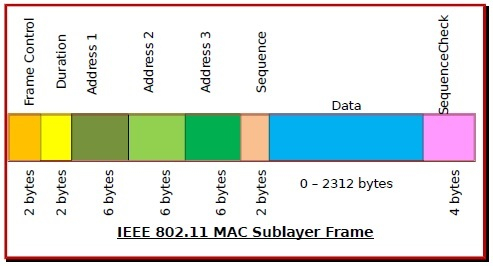
 Data Structure
Data Structure Networking
Networking RDBMS
RDBMS Operating System
Operating System Java
Java MS Excel
MS Excel iOS
iOS HTML
HTML CSS
CSS Android
Android Python
Python C Programming
C Programming C++
C++ C#
C# MongoDB
MongoDB MySQL
MySQL Javascript
Javascript PHP
PHP
- Selected Reading
- UPSC IAS Exams Notes
- Developer's Best Practices
- Questions and Answers
- Effective Resume Writing
- HR Interview Questions
- Computer Glossary
- Who is Who
The 802.11 MAC Sublayer Protocol
IEEE 802.11 standard, popularly known as WiFi, lays down the architecture and specifications of wireless LANs (WLANs). WiFi or WLAN uses high frequency radio waves instead of cables for connecting the devices in LAN. Users connected by WLANs can move around within the area of network coverage.
The 802.11 MAC sublayer provides an abstraction of the physical layer to the logical link control sublayer and upper layers of the OSI network. It is responsible for encapsulating frames and describing frame formats.
MAC Sublayer frame of IEEE 802.11
The main fields of a frame of wireless LANs as laid down by IEEE 802.11 are −
- Frame Control − It is a 2 bytes starting field composed of 11 subfields. It contains control information of the frame.
- Duration − It is a 2-byte field that specifies the time period for which the frame and its acknowledgement occupy the channel.
- Address fields − There are three 6-byte address fields containing addresses of source, immediate destination and final endpoint respectively.
- Sequence − It a 2 bytes field that stores the frame numbers.
- Data − This is a variable sized field carries the data from the upper layers. The maximum size of data field is 2312 bytes.
- Check Sequence − It is a 4-byte field containing error detection information.

Avoidance of Collisions by 802.11 MAC Sublayer
In wireless systems, the method of collision detection does not work. It uses a protocol called carrier sense multiple access with collision avoidance (CSMA/CA).
The method of CSMA/CA is −
- When a frame is ready, the transmitting station checks whether the channel is idle or busy.
- If the channel is busy, the station waits until the channel becomes idle.
- If the channel is idle, the station waits for an Inter-frame gap (IFG) amount of time and then sends the frame.
- After sending the frame, it sets a timer.
- The station then waits for acknowledgement from the receiver. If it receives the acknowledgement before expiry of timer, it marks a successful transmission.
- Otherwise, it waits for a back-off time period and restarts the algorithm.
Co-ordination Functions in 802.11 MAC Sublayer
IEEE 802.11 MAC Sublayer uses two co-ordination functions for collision avoidance before transmission −
-
Distributed Coordination Function (DCF) −
- It is a mandatory function used in CSMA/CA.
- It is used in distributed contention-based channel access.
- It is deployed in both Infrastructure BSS (basic service set) as well as Independent BSS.
-
Point Coordination Function (PCF) −
- It is an optional function used by 802.11 MAC Sublayer.
- It is used in centralized contention-free channel access.
- It is deployed in Infrastructure BSS only.

